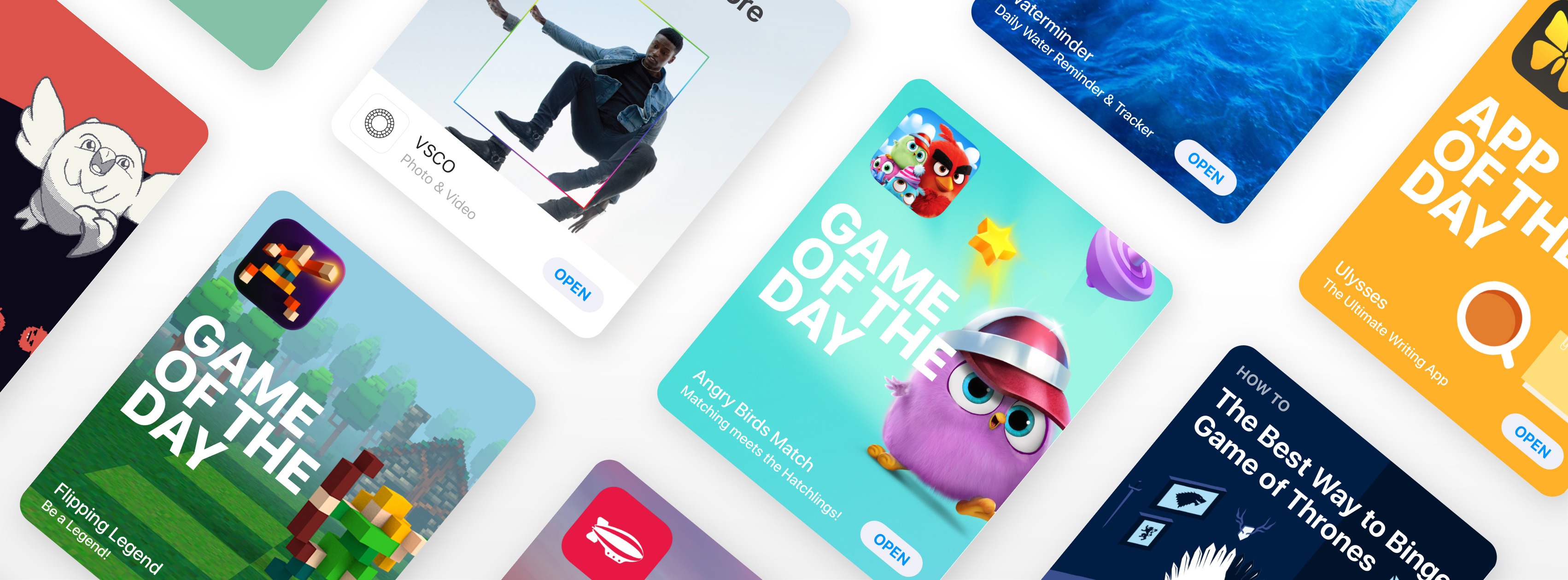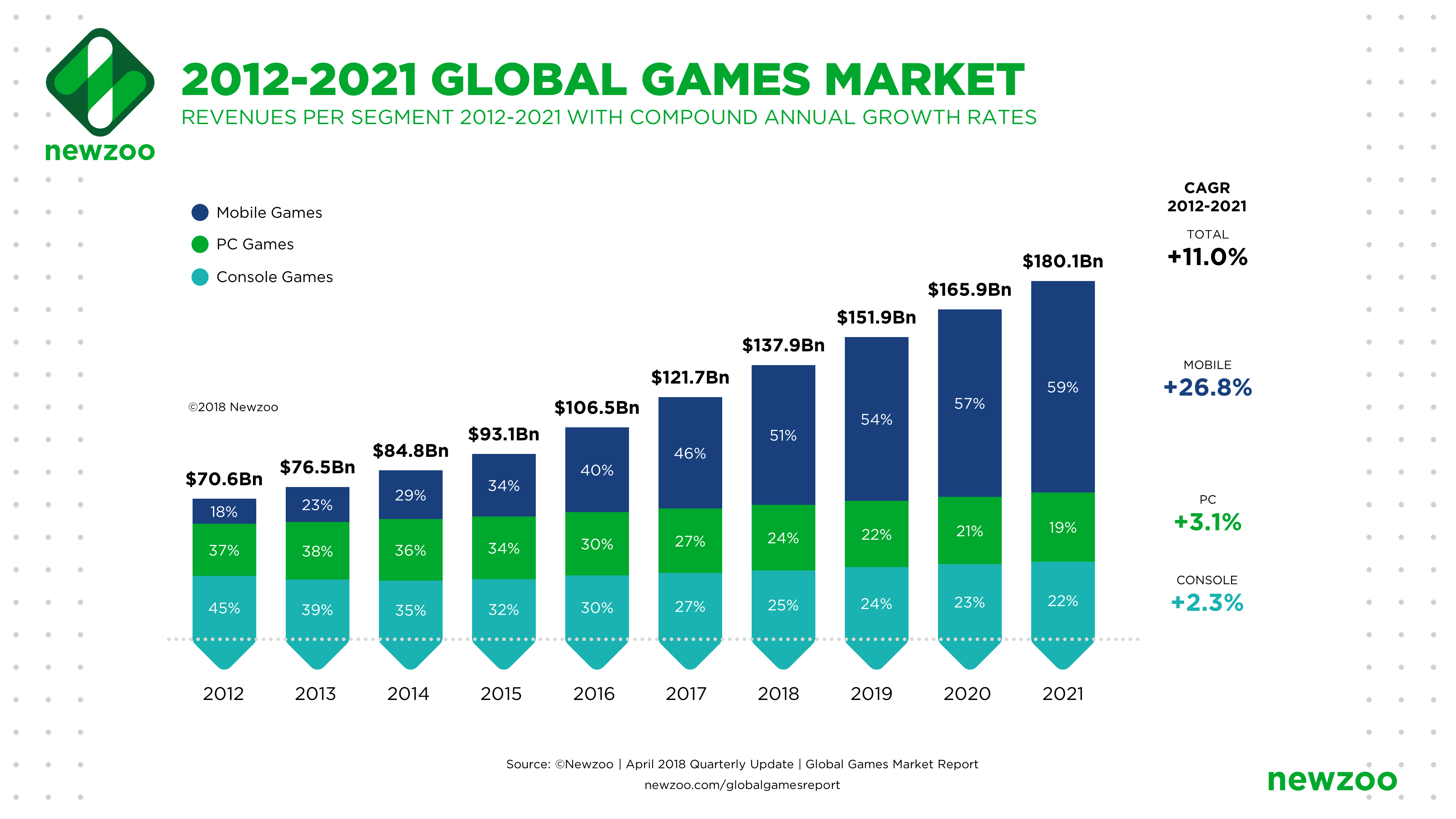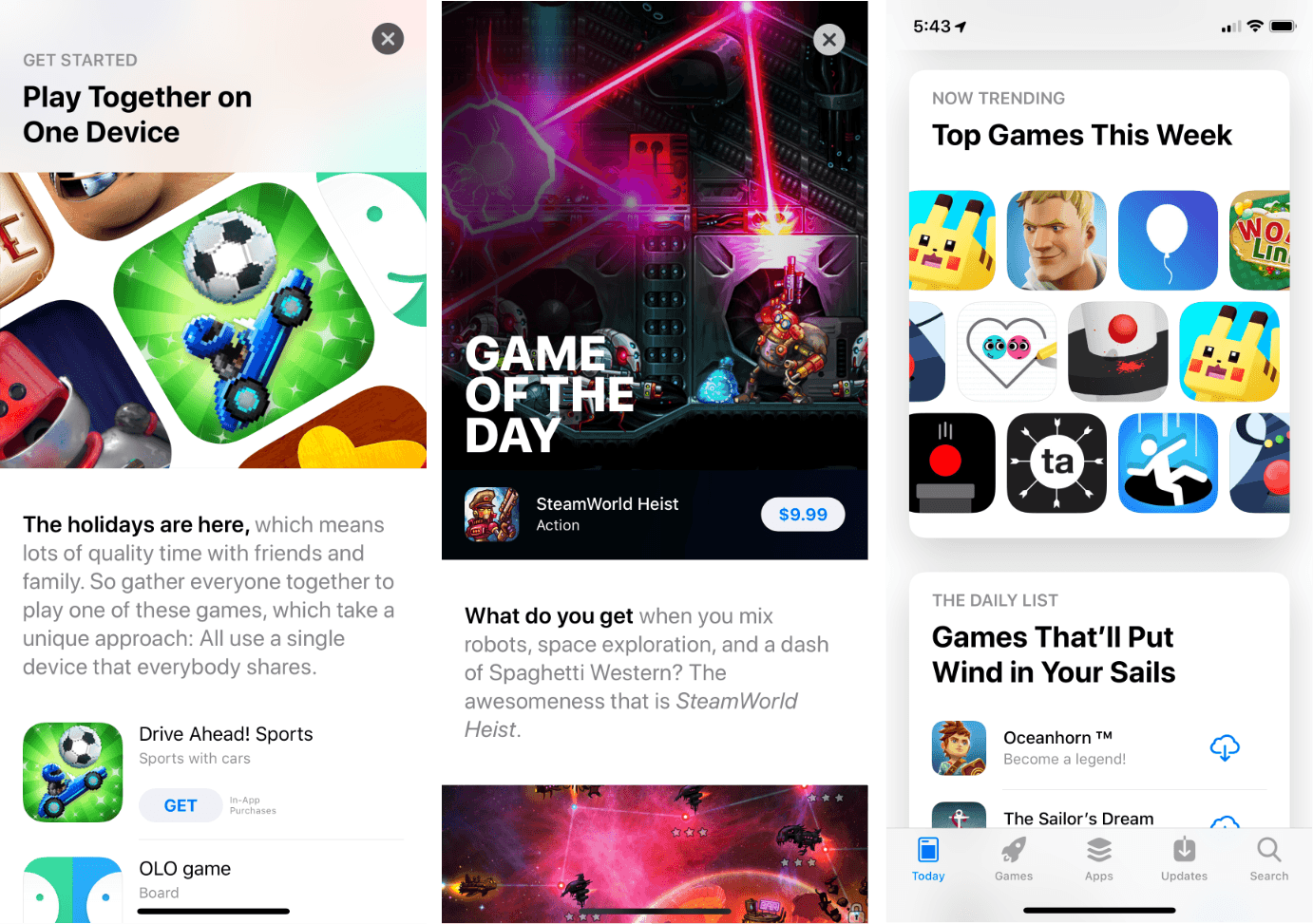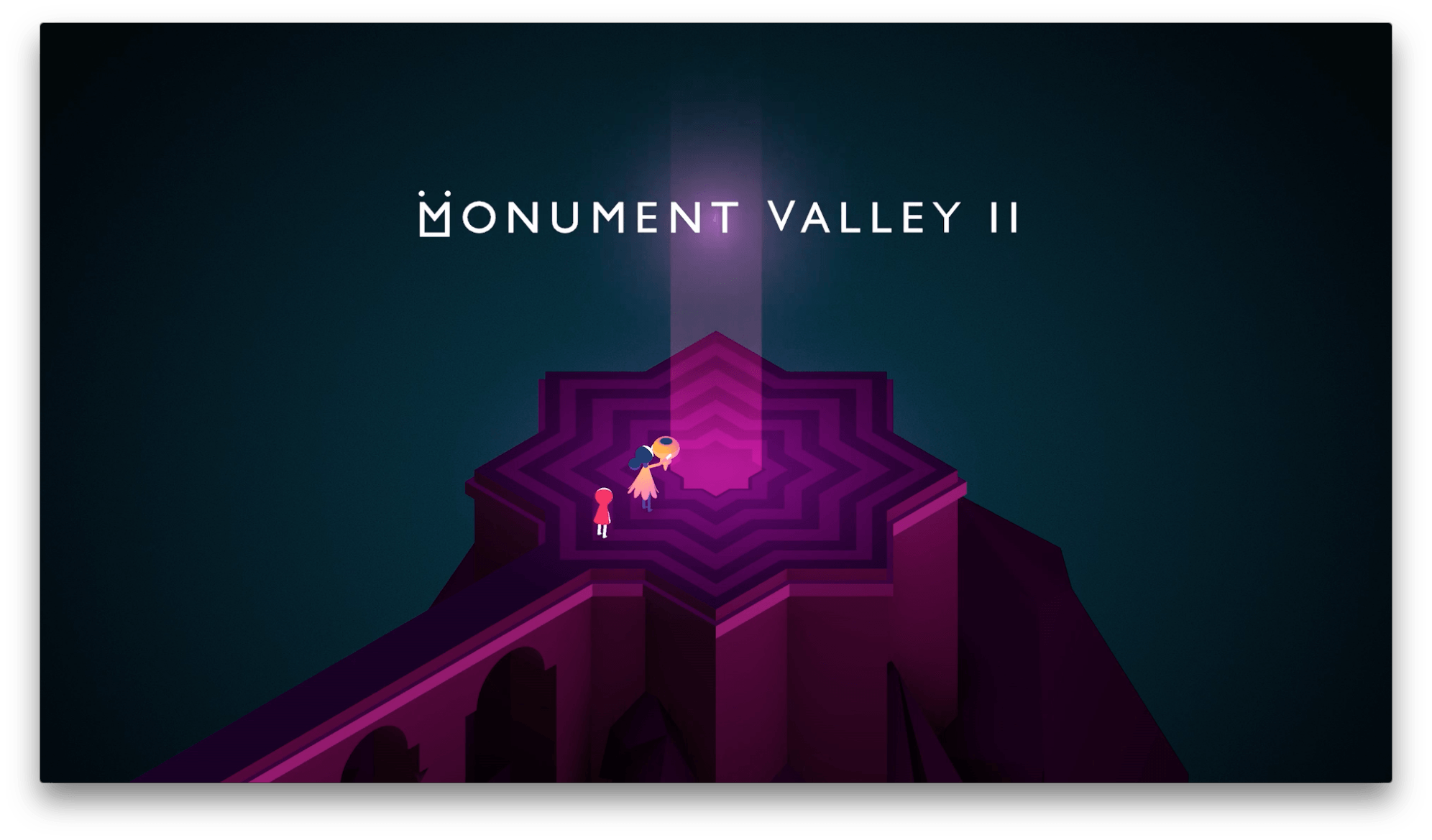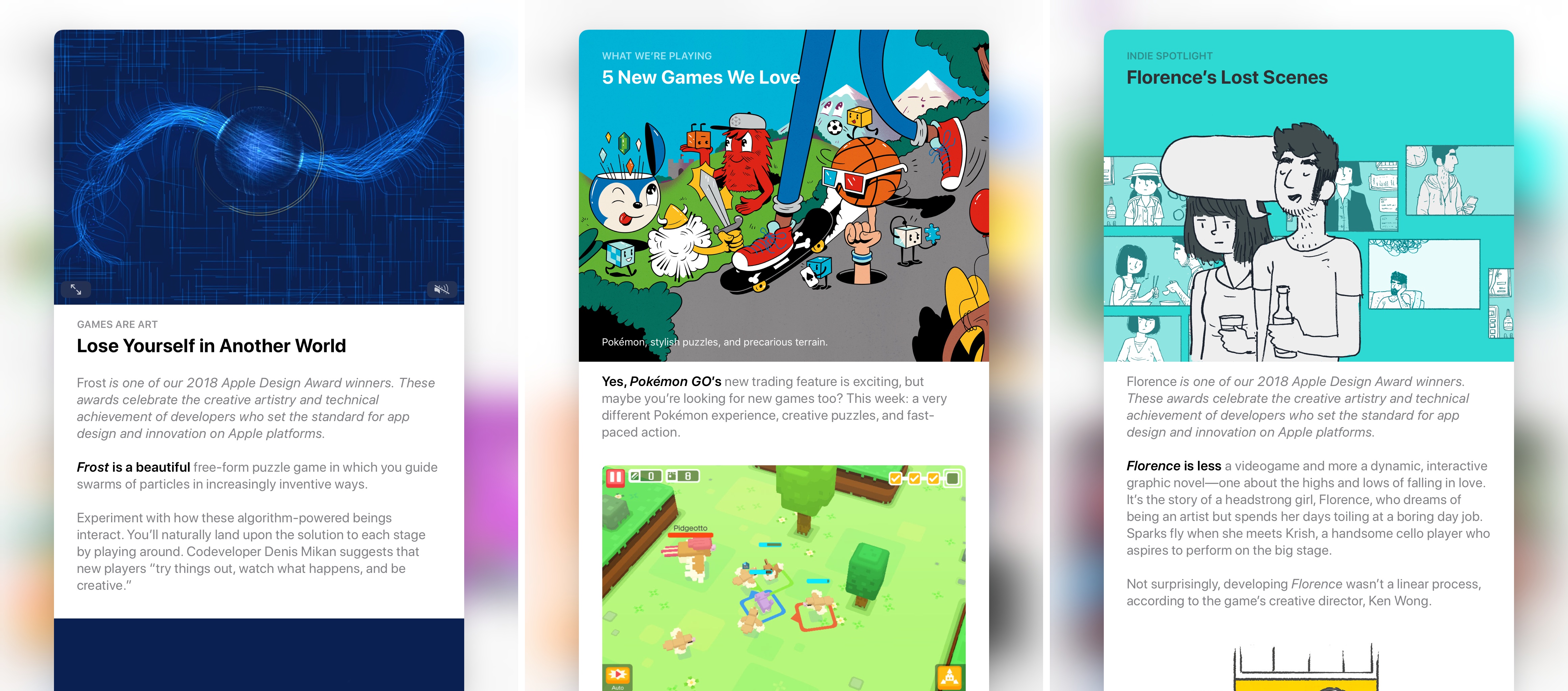Nowhere has the App Store’s impact been more profound than the game industry. Roughly one-third of the 500 initial apps that debuted on the App Store were games. The percentage of games on the App Store has risen over the past 10 years, but not by much. By some estimates, between 35 and 40 percent of the App Store’s apps are games today. What has changed is the size of the Store. With over 2.1 million apps currently available for download, that means around 800,000 are games.
Mobile gaming has become the primary driver of growth in the game industry over the past several years. According to a recent report by Newzoo, the mobile game industry, in which iOS plays a central role, will be a $100 billion market in just three years time.
The success of games on iOS parallels the phenomenal success of the iPhone and App Store. The iPhone’s hardware played a significant role with its novel design that provided game developers with the flexibility to experiment. Just as important, though, was the advent of In-App Purchases. Games, like other apps, were originally free or paid. When In-App Purchases came along, a whole category of games that offered in-app, paid consumables, level packs, and other digital goods was born that has been wildly successful for many game developers.
Now, free-to-play games with In-App Purchases dominate the top grossing charts and a relatively small cadre of games soak up the majority of money spent on the App Store, making it harder than ever to succeed as a game developer on the App Store. It’s a familiar story faced by app and game developer alike. Notwithstanding the stiff competition in the games category though, the mobile game market’s sheer size has allowed creative, independent game developers to find ways to succeed on the App Store.
Perhaps most exciting of all though, the success of mobile games has led to an enormous influx of people into gaming who would never have considered themselves gamers. That creates a tremendous opportunity for Apple and game developers which has become all the more interesting as the constraints of early iOS devices have been replaced by hardware that approaches the capability of game consoles. Mobile games stand at a pivotal moment in time that has the potential to upend preconceptions about the distinction between mobile and other video games, but to understand what the future might hold, it’s instructive to start by looking at the past 10 years.
A Blank Canvas
When the App Store debuted, mobile games were dominated by the Nintendo DS and Sony PSP. Mobile phone manufacturers were looking for ways into the gaming market at the time too with attempts like the Nokia NGage, which was released a few years before the App Store launched. Unlike many other devices though, the iPhone was a general computing device that people carried with them everywhere, which exposed games to a new, broader audience than ever before.
The combination of the iPhone and App Store freed game makers from a wide variety of long-standing constraints. Gone were the many buttons found on other devices. The iPhone was controlled from a buttonless glass surface, allowing developers to create completely custom control schemes based on touch. Also eliminated was physical media such as game cartridges and complex side loading and sync mechanisms. The App Store was just another iPhone app, and it downloaded apps to the device’s internal storage, greatly simplifying the process of acquiring games.
The magic of the iPhone is that it becomes whatever app you launch. The device’s smooth blank surface coupled with sensors not found in other game devices made the iPhone a playground for developer experimentation. As game designer Zach Gage told us in an interview published on AppStories today:
It was personally…alluring just because it was so new, and when something is that new and that transformative it feels like an opportunity to do things that have never been done before – to be the first person to do something…As an artist or a creator, it’s such an exciting possibility.
It’s that allure and opportunity to explore and be the first to try new game mechanics that attracted so many developers like Gage to the iPhone.
The iPhone introduced developers to a host of new sensors they could access with their games. There was an accelerometer that made games like Labyrinth, the marble maze game, possible from the day the App Store launched. The combination of realistically rendered wooden mazes, sound design, and the iPhone’s accelerometer created an experience that felt uncannily like playing a real wooden marble maze game.
As time has marched on, the number of sensors in the iPhone has multiplied. Each has provided new opportunities for experimentation by developers. No single game I’ve played makes better use of those sensors than Blackbox by Ryan McLeod. The Apple Design Award-winning game takes advantage of everything the iPhone’s hardware has to offer, making the sensors the key to unlocking a series of tricky puzzles. When integrated with games, the iPhone’s sensors add a level of tactile interaction that other platforms were unable to match in the early days of the iPhone.
The iPhone SDK also democratized development like no other platform, further fueling the explosion of independent game development. Anyone could download the iPhone SDK for free and begin building games. It wasn’t until you had something ready to sell that you had to pay the relatively modest $99 fee necessary to put your game on the App Store. That opened up the iPhone to anyone with a Mac and a good idea. Game studios weren’t rendered irrelevant, but they weren’t necessary either.
The iPhone’s physical design was not without its challenges though. Its lack of buttons eliminated an important tactile feedback loop. Early iPhones also lacked the power to run sophisticated games. Careful management of resources was critical to achieving an acceptable user experience.
Despite those constraints, or perhaps because of them, game development flourished on the iPhone from the very beginning. Limitations meant that early iPhone games were relatively short, casual experiences, which suited the iPhone’s small screen and portable nature well.
Still, the long-term success of the iPhone as a game platform was far from guaranteed. What propelled the iPhone over the course of a decade from a curiosity to a central part of the game industry was the ability of developers to make money.
The Rapid Evolution of the iOS Games Business
When the App Store opened for business you could sell apps for an up-front fee or give them away – that was it. But less than a year later with the introduction of iPhone OS 3.0, Apple gave developers the ability to offer In-App Purchases. However, the feature was limited to paid apps initially – that only lasted about three months though. By the fall of 2009, In-App Purchases could be offered by free apps too, opening the floodgates to a new category of freemium iPhone apps.
Competition among app and game developers was already pushing prices closer and closer to free by 2009. Of course, free with no other revenue strategy was unsustainable, but it was also alluring. The difference between a $0.99 app and a free app may seem small, but as Nintendo learned with Super Mario Run, the psychological barrier to paying for an app is strong. In fact, most people would rather suffer through in-game ads than pay.
With In-App Purchases, Apple allowed developers to remove the initial psychological download barrier posed by charging for apps and sell gamers in-app items that ranged from game levels, decorative items, consumables to enhance gameplay, and more. The approach worked. According to a Flurry Analytics study from 2013 80-85% of all apps between 2010 and 2012 were free, and many offered In-App Purchases.
The practice of offering games for free and trying to separate players from their money later took an early dark turn that persists today. Competition among game developers is so extreme that it’s led them to carefully tune games, sometimes with the help of psychologists, to frustrate gamers just enough to encourage them to make In-App Purchases to facilitate gameplay without chasing them away.
It’s important to note, however, that not all In-App Purchases amount to speed bumps designed to entice players to open their wallets to make games playable. Many games offer level packs and other additional content that provides real value to games.
In-App Purchases coupled with ads can also be used strategically to combat cloners, as Zach Gage shared with us during his AppStories interview. By offering games free with ads, Gage removes the incentive to clone his games and sell them for less. With In-App Purchases, fans can play games like Flipflop Solitaire without ads and access additional features, allowing Gage to reach a bigger audience and avoid being undercut by cloners.
Like so many other online businesses, in-app revenue sources are highly concentrated. According to one study conducted in January 2014:
only 1.5 percent of active players surveyed in January actually made a purchase in that month. About 50 percent of revenue comes from the top 10 percent of the players who do make purchases.
That relatively small group of players, know as ‘whales,’ a term borrowed from the gambling industry, make up an astounding portion of In-App Purchase revenue.
The concentration of revenue is just as pronounced if you look at game developers’ earnings. According to a recent Apptopia study, the top 50 grossing games in the US took home 76% of total App Store revenue. From 2014-2017 Apptopia found that only 2,624 games reached the top 50 grossing list – a small fraction of the 800,000 on the Store – with an average stay on that list of just 27.75 days.
At first blush, the numbers make it look as though there can’t possibly be any room for independent game developers and small studios to build a sustainable business or charge a flat, up-front price for them. However, that’s where the colossal size of the App Store comes into play. While big-budget games may grab most of the revenue, there’s still room for smaller developers to succeed.
Take Monument Valley and its sequel for example. The original game earned $5.8 million in its first year. The sequel earned nearly double that, collecting $10.4 million in its first year.
Some might discount the performance of Monument Valley 2, arguing that it’s unique because it launched onstage at WWDC in 2017. That’s true, but the stage time the game received at WWDC is part of a broader push by Apple to highlight independent games alongside big-budget free-to-play games.
This approach can be seen throughout the App Store, especially since the iOS 11 redesign. The App Store’s Today tab has featured many top game developers including solo developers like Zach Gage, games like Alto’s Odyssey, and collections of apps that are heavy on indie titles like The Best Games You’ve Never Played, and even Pay Once and Play, a direct counterweight to the prevalence of games with In-App Purchases. Many Apple Design Award winners have come from smaller development shops too.
It’s certainly not easy making it as an indie game developer on the App Store, but it isn’t easy for more prominent publishers either. Competition is fierce, but growth areas remain that should maintain the brisk growth of games on the App Store for years to come.
Does Apple Understand Gaming?
According to Newzoo, mobile games will continue to grow faster than the rest of the game industry. In fact, 2018 is notable because it is projected to be the first year that mobile game revenues globally will be greater than other game categories.
By 2021, the mobile game market is projected to be over $100 billion globally. That’s the kind of number you can safely bet hasn’t escaped notice in Cupertino. Even so, it often feels like Apple has succeeded in games despite itself.
I expect the magnitude of the App Store’s success caught even Apple off guard. Early years involved severe growing pains where app review took weeks as Apple tried to keep up with the pace of submissions to the Store. Much of that onslaught was games.
With the iPhone, Apple had built a remarkable device that could become anything a developer could imagine. New sensors opened gameplay opportunities that weren’t available before, and best of all, touch input made games absorbing in a way that was unheard of before its launch.
Constraints on the iPhone’s computing power were the primary limiter on games that could be built. However, demand was so great for even simple, casual games that Apple didn’t need to do much other than maintain the status quo and watch as hundreds of thousands of games poured into the Store.
And preserving the status quo is exactly what they’ve done. As Eddy Cue articulated it to BuzzFeed in late 2015:
When we first announced the iPhone, we didn’t tout it as a gaming device. But games became a huge part of iPhone, because it turns out that a lot more people than just hardcore gamers love games. We expanded the market. I think the vast majority of people around the world probably aren’t looking to buy an Xbox or PlayStation. But that doesn’t mean they don’t enjoy playing games. I think Apple TV expands the gaming market to those people.
That sounds an awful lot like a company that’s content to continue to collect the ‘found money’ dropped on its doorstep in the form of casual games.
Hardware has become exponentially more powerful, making games that approach console-level quality possible on mobile devices for the first time – but the trouble is, Apple has done little to foster the growth of iOS gaming into the traditional console game market. Perhaps the biggest disappointment has been the Apple TV. First introduced the same day as the iPhone, its hardware has been far less frequently updated while Apple has experimented with different strategies to enter video streaming.
When an App Store was added to the Apple TV in 2015, games were featured prominently, even though controllers were left to third parties to develop. After early signs suggested that Apple would let developers require third-party controllers, Apple reversed course and mandated that all games work with the Apple TV Siri Remote. Apple relented nine months later and now lets developers require a third-party MFi controller, but the damage was done as developers lost interest and trust in the Apple TV.
Two things bother me about MFi controllers. First, if Apple were genuinely interested in promoting games, it would help to include a controller with the Apple TV or at least provide separate configurations with and without a controller.
Second, Apple should make games itself,1 which would demonstrate to it how inadequate the Apple TV’s Siri Remote is for controlling a game. Also, standard Bluetooth is too laggy for much other than casual games. I’d like to see Apple put some of the synchronization work it’s done for the AirPods to use with an Apple-designed controller.
The iPad has fared better as a game platform with the ever-increasing quality of its displays, CPU, and GPU performance. With a wide variety of screen sizes all the way up to TVs and powerful hardware, the time is ripe for games on iOS to start taking on consoles. However, Apple seems content to follow the casual game path established by the iPhone when there was just one screen size and the device was much less capable.
Game developers are excited about the prospect of bringing uncompromising console games to iOS. Earlier this year PUBG and Fortnite launched versions of their popular console games on iOS. According to Rolling Stone, this year at the Game Developer Conference Tim Sweeny, the CEO of Fortnite-creator Epic Games, said:
“Right now we are ten years into the mobile gaming revolution. This is a revolution that’s brought more than 3.5 billion new computing device owners into the market in the form of smartphones and tablets and billions of new gamers. So it’s one of the greatest events in the history of the game industry.”
Almost more importantly, though, Sweeney noted that while that 2008 event initially split the game industry into two halves - high end gamers and gaming and casual gamers - a new trend “upending the game industry” is seeing that split disappear as the games made for consoles or computers are now showing up nearly unaltered on smartphones.“
Epic’s bullishness on mobile gaming is notable because it wasn’t always this way. In 2011, Epic’s president Mike Capps was quoted as saying that dollar apps on iOS were killing the traditional games industry. However, the combination of adopting a free-to-play business model and hardware advancements have turned things around for Epic. Fortnite, which only earns money from In-App Purchases that don’t enhance gameplay, earned $100 million on iOS in just 90 days.2
Five years ago, Federico wondered what iOS gaming would be like at the end of the App Store’s first decade:
What’s the App Store going to be like in 2018? Can we imagine, two or three years from now, simultaneous and equal releases of AAA games across consoles and iOS? And if so, how will the App Store’s numbers play to Apple’s advantage against Sony, Microsoft, Nintendo, and Valve?
At the time, AAA game titles like Metal Gear Solid 4 and XCOM were being adapted for iOS 8-9 months after their console launches, albeit with compromises to accommodate Apple’s hardware at the time.
Today, we are very close to what Federico imagined in 2013, but held back, at least in part, by Apple’s lukewarm interest in console-style games. I love casual games and expect them to remain at the center of the iOS gaming experience for a long time, but Apple is missing an opportunity to introduce console-like gaming experiences to a new audience and give users another reason to stick with iOS over other platforms.
To be fair, Apple is not sitting idly by either. Augmented reality has the potential to have a significant impact on gaming in years to come, and Apple has been pushing forward aggressively with updates to its ARKit APIs. That said, AR games are still little more than playable demos. Deeper AR gaming experiences will come, but supporting more complex games on iOS is something Apple can and should do now.
Now more than ever, games are part of our shared culture. Apple and the App Store have played prominent roles in that over the past 10 years. Mobile gaming wasn’t new when the iPhone debuted, but most people didn’t carry a dedicated portable game device with them every day. That changed with the iPhone.
It’s a story that closely follows the story of all apps. A world where millions of people carry tiny computers with them wherever they go has been transformative. It’s made gaming a part of everyday life for more people than ever before. Large parts of the population that would never identify as gamers are now, in fact, gamers.
Many of the games we’ve played over the past ten years have become iconic cultural touchstones. Games like Angry Birds introduced characters so beloved they became merchandising opportunities, showing up on t-shirts and even in movies. Others like Clash of Clans, Candy Crush Saga, and Words with Friends have become obsessions bordering on addictions for some. Still, other games like Monument Valley, Alto’s Adventure, and Sword & Sworcery are legitimate works of art, creating experiences carefully tailored to mobile devices.
Despite the success of games on the App Store, it feels like Apple has come to a crossroads. On the one hand, the company is building a broad-based media platform, of which games are an important part. On the other hand though, it seems like Apple is at risk of losing the chance to pick up a big segment of the game market.
A similar thing happened with pro apps on iOS. The early success of the App Store resulted in fantastic single-purpose apps. When Apple wanted to sell the iPad as a professional productivity device though, it had to change direction, adopt subscriptions, and make other adjustments to try to jumpstart a segment of the App Store that hadn’t developed as other app segments had.
The good news for iPad users is that Apple recognized the shortcomings of the iPad app market and is working to fix it. I hope the company will realize that it needs to do more with games too. Success can make it hard to see issues like this, but if Apple’s goal is to become a media platform that offers a broad cross-section of culturally relevant media, it needs to point its efforts in the direction the wind is already blowing and consider what it can do to offer console-level games on its devices.
One thing is sure: games on the App Store will continue to change and evolve regardless of the path Apple chooses. No single app category has had a more profound impact economically and culturally than games. It’s a powerhouse fueled by the desire for fun and distraction set in an intensely competitive arena that will no doubt continue to push the genre forward, amazing and delighting gamers into the App Store’s next decade.
- Apple did dip its toes into developing games with Texas Hold ‘Em, which debuted on the App Store on launch, but the game was removed from the store in 2011, and Apple hasn’t launched a game since. ↩︎
- Fortnite’s early sales figures are even more impressive given that the game was only available by invitation for the first two weeks it was on iOS. ↩︎


